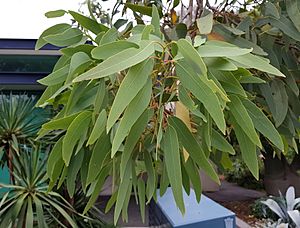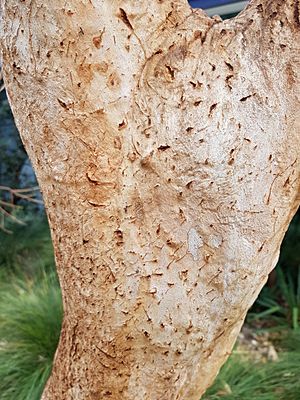Eucalyptus gregoryensis facts for kids
Quick facts for kids Eucalyptus gregoryensis |
|
|---|---|
 |
|
| E. gregoryensis in the Royal Botanic Gardens Victoria | |
| Scientific classification | |
| Genus: |
Eucalyptus
|
| Species: |
gregoryensis
|
| Synonyms | |
|
Eucalyptus gregoriensis N.G.Walsh & Albr. orth. var. |
|
Eucalyptus gregoryensis is a special kind of small tree or a mallee. It only grows in the Northern Territory in Australia. This tree has smooth, powdery white bark. Its leaves are long and thin, or slightly curved. The flowers are white, and they grow from buds that usually appear in groups of three. After flowering, it produces fruit that looks like a small cup.
Contents
What Does Eucalyptus gregoryensis Look Like?
Eucalyptus gregoryensis is a small tree or a mallee. A mallee is a type of eucalyptus that grows many stems from a large, woody base. This tree usually grows up to about 8 meters (26 feet) tall. It has a special woody swelling at its base called a lignotuber. This helps it regrow after fires.
The tree's branches often hang down a bit, giving it a "semi-weeping" look. Its bark is smooth and powdery white. When the bark is new, it can look pale pink.
Leaves of the Eucalyptus gregoryensis
Young plants and new shoots (called coppice regrowth) have dull, grey-green leaves. These leaves are broadly lance-shaped or egg-shaped. They are about 8 to 18 centimeters (3 to 7 inches) long and 4 to 9 centimeters (1.5 to 3.5 inches) wide.
The adult leaves grow in an alternating pattern along the stem. They are lance-shaped or slightly curved. Both sides of the leaves are a dull green to grey-green color. They are quite long, about 8 to 22 centimeters (3 to 8.5 inches) long. They are also about 1.2 to 3 centimeters (0.5 to 1.2 inches) wide. The base of the leaf narrows down to a stalk called a petiole, which is about 8 to 30 millimeters long.
Flowers and Fruit of the Eucalyptus gregoryensis
The flower buds usually grow in groups of three. Sometimes, you might see them in groups of seven. They appear in the leaf axils (the angle between a leaf and the stem). These buds grow on a short, unbranched stalk called a peduncle, which is about 2 to 4 millimeters long.
The individual flower buds are either directly attached (called sessile) or have very short stalks (called pedicels) up to 1 millimeter long. When the buds are ready to open, they are oval to spindle-shaped. They are about 6 to 8 millimeters long and 3 to 4 millimeters wide. Each bud has a rounded or cone-shaped cap called an operculum.
The flowers themselves are white. After the flowers bloom, the tree produces a woody fruit. This fruit is a capsule that looks like a cup or is half-sphere shaped. It's about 4 to 5 millimeters long and 5 to 6 millimeters wide. The parts that release the seeds (called valves) stick out above the rim of the fruit.
How the Eucalyptus gregoryensis Got Its Name
The Eucalyptus gregoryensis was first officially described by two botanists. Their names were Neville Walsh and David Edward Albrecht. They wrote about it in 1998 in a science journal called Muelleria. Interestingly, the name they first gave it was slightly different: E. gregoriensis.
The first samples of this tree, which helped scientists describe it, were collected in 1996. They were found near a small river that flows into the East Baines River. This area is located inside the Gregory National Park.
Meaning Behind the Name
The specific part of the name, gregoryensis, comes from the Gregory National Park. This park was named after an explorer named Augustus Charles Gregory. He explored this particular area of Australia in the years 1855 and 1856.
Where Does Eucalyptus gregoryensis Grow?
This tree has a rather small natural range. It is found in the Gregory National Park and also in the Victoria River Downs region. Both of these places are in the top end of the Northern Territory in Australia.
You can find Eucalyptus gregoryensis growing on sandstone plateaus and cliffs. It often grows near seasonal water courses, which are streams or rivers that only flow during certain times of the year.


